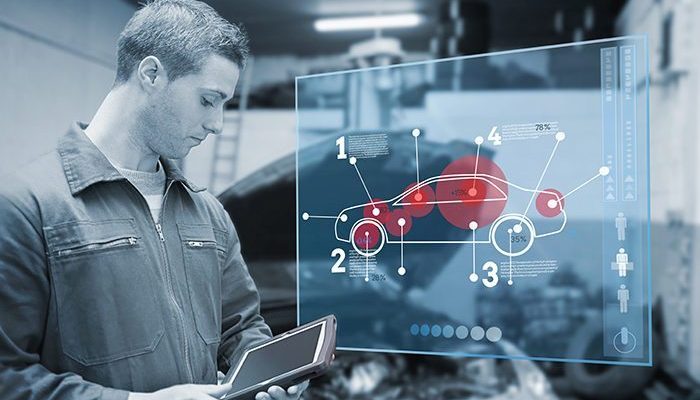Is Augmented Reality (AR) the next big thing in field service?
Nov 01, 2016 • Features • Augmented Reality • Future of FIeld Service • Bill Pollock
Bill Pollock, President and Principal Consulting Analyst with Strategies for GrowthSM states the case for Augmented Reality being the next transformational technology in field service...
At a UK Field Services Summit earlier this year, I was asked to cite what I believe would be the “next big thing” in field service. I suggested “Augmented Reality”, or AR. Why? Because we, as an industry, really cannot do things any quicker than in real time; and we can’t make repair tutorials any smaller, more compact and/or transportable than they already are.
What we can do, however, is make it easier for the field technician to “see” what needs to be done, in real time, and with an “augmented” view of what reality alone cannot, and does not, necessarily provide.
Companies like PTC, a global leader in Service Lifecycle Management (SLM) through its strategic partnership with ServiceMax believe that by leveraging the combination of “two transformational technology trends – Internet of Things (IoT) and Augmented Reality (AR)”, it can now deliver “a new class of products that merge the digital and physical worlds.”
The company further cites that when coupled with the IoT and analytics platforms, AR “unlocks a world of possibilities for creating new ways to design products, to monitor and control products, and to instruct operators and technicians in the appropriate methods of use and service.”
AR had largely focused in applications for the gaming industry; that is, for recreational and entertainment use, rather than for use in a more traditional B2B environment.
However, as more and more Millennials begin to enter the global field technician workforce, they bring along with them not only the skills required to take full advantage of the “new” technology, but also a full appreciation – and affinity for – the technology that has been powering their gaming activities for the last several years.
Even for the existing field technician workforce, the technology is eminently easy to learn, easy to use and fairly intuitive, as well.
According to Jim Heppelmann, CEO at PTC, AR is “a technology that superimposes computer-generated images on top of real world objects, ranging from video game characters to data fields” and, as such, a technology that “can extend a variety of experiences into new arenas as well as provide useful information to consumers” – and customers. Heppelmann further stated that “I think a lot of companies who make and service [products] want to be able to pass information downstream to consumers. [But] rather than a big PDF file, they [now] can say let me augment everything you need to know and nothing more” – and only through AR, is there a means for both explaining the need for service, as well as the actual procedures for performing the “fix”.
There is presently a great deal of “untapped potential for AR in B2B,” and Heppelmann believes that by “using an AR-assisted tool, users of a medical equipment device, for example, would be able to do a routine service inspection themselves, saving the time and cost of sending a service person out on a call (which can run thousands of dollars).”
Because of what IoT is enabling, more and more products are now a mixture of digital and part physical content.
But, isn’t this the same foundation upon which the gaming industry has built itself on over the last generation (i.e., Generation X) and beyond? The concept is really nothing very new – and the technology has already been available for a quite a while.
So, why not apply the same technology to a practical business application as well? In other words, why should the technology be restricted primarily to gamers primarily for recreational purposes?
Basically, AR works in conjunction with the digital twin concept “to enable a new generation of predictive and prescriptive analytics that bring about new business models where the equipment OEMs will retain ownership of its equipment and provide continuous and optimised service on a subscription-based model”.
Once in place, these capabilities can then be used to support the next generations of Augmented Reality applications as they emerge over time.
There is no question that AR will be able to assist in an SLM environment; that is, to provide the field technician (who may not ever have been called upon to service a particular piece of equipment) to still be able to perform the repair by “overlaying” an enhanced (again, augmented) reality – in 3D motion – over and above what he or she would otherwise be able to visualise, in order to make a quick, clean and complete fix. In fact, AR is already being used for these and myriad other purposes in the field.
Major global brands, including Band-Aid, Kentucky Fried Chicken (KFC), Mattel and Pepsi have already been using AR for some time. Other major users include Bumble Bee tuna, Guinness Book of World Records, Hyundai, John Deere, KTM Bike, Schneider Electric and Sysmex, etc.
For many field services organisations, AR is now routinely being used to assist field technicians in their ability to perform repairs on equipment they may not have been exposed to previously; have not had any formal, or individual, training or instruction on how to repair; and/or do not readily have access to product specs, schematics, repair manuals or service histories.
Augmented Reality has already made it easier to follow – and understand – otherwise complicated gaming scenarios and sports events for the millions of individuals that have been using the technology for years.
Isn’t time that it was also used to make it easier to perform field service activities? Based on what I have already seen (i.e., and you really do have to see it to believe it!) the answer is resoundingly, “Yes” – and the view from the bridge (i.e., between real-time and Augmented Reality) appears to be breathtaking





















 Field Service News is published by 1927 Media Ltd, an independent publisher whose sole focus is on the field service sector. As such our entire resources are focused on helping drive the field service sector forwards and aiming to best serve our industry through honest, incisive and innovative media coverage of the global field service sector.
Field Service News is published by 1927 Media Ltd, an independent publisher whose sole focus is on the field service sector. As such our entire resources are focused on helping drive the field service sector forwards and aiming to best serve our industry through honest, incisive and innovative media coverage of the global field service sector.
Leave a Reply